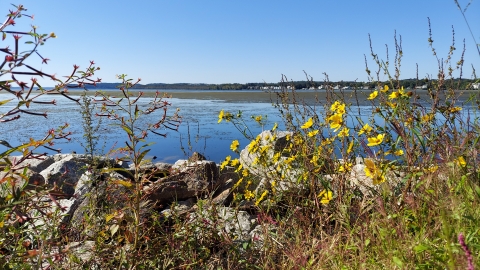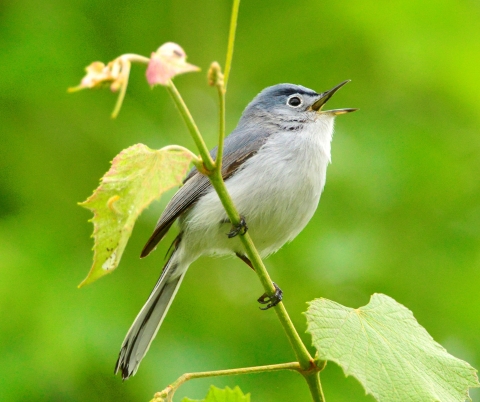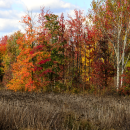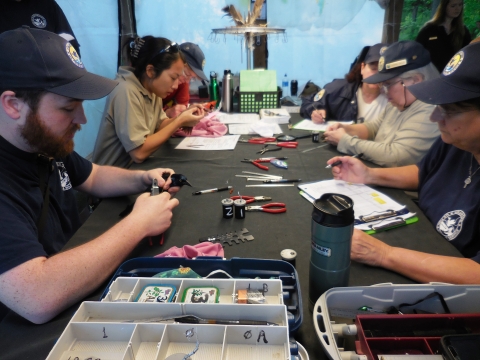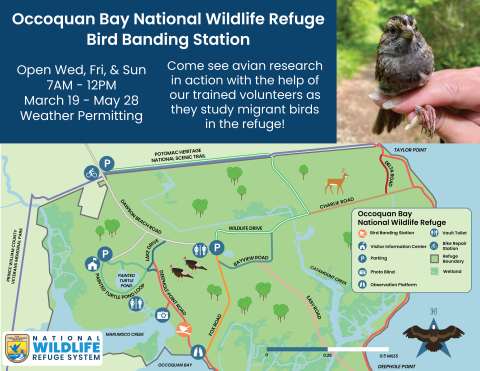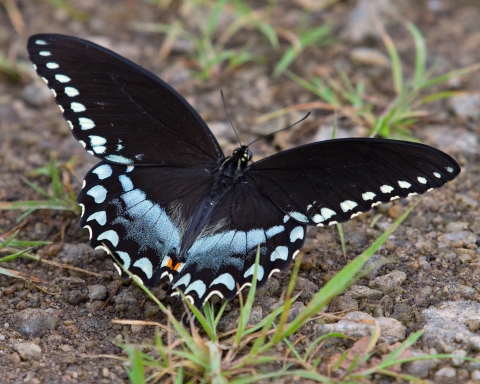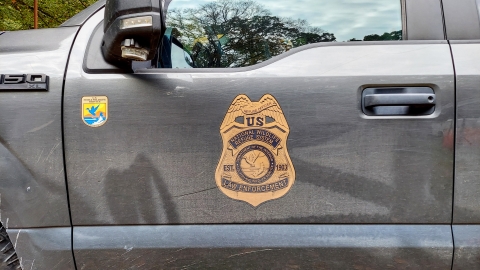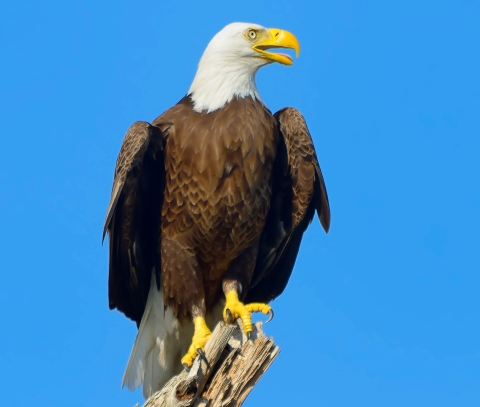What We Do
Wildlife conservation is at the heart of the National Wildlife Refuge System. It drives everything on U.S. Fish and Wildlife Service lands and waters managed within the Refuge System, from the purposes for which a national wildlife refuge national wildlife refuge
A national wildlife refuge is typically a contiguous area of land and water managed by the U.S. Fish and Wildlife Service for the conservation and, where appropriate, restoration of fish, wildlife and plant resources and their habitats for the benefit of present and future generations of Americans.
Learn more about national wildlife refuge is established to the recreational activities offered to the resource management tools used. Using conservation best practices, the Refuge System manages Service lands and waters to help ensure the survival of native wildlife species.
Management and Conservation
Refuges deploy a host of scientifically sound management tools to address biological challenges. These tools span active water management to wilderness character monitoring, all aimed at ensuring a balanced conservation approach to benefit both wildlife and people.
At Occoquan Bay National Wildlife Refuge, the U.S. Fish and Wildlife Service works to preserve the grasslands, wetlands and forests that have sheltered wildlife for centuries. Using the refuge's comprehensive conservation plan as a guide, habitats are surveyed and managed using a variety of methods.
Comprehensive Conservation Planning
The National Wildlife Refuge System Improvement Act of 1997 requires comprehensive conservation plans for each national wildlife refuge national wildlife refuge
A national wildlife refuge is typically a contiguous area of land and water managed by the U.S. Fish and Wildlife Service for the conservation and, where appropriate, restoration of fish, wildlife and plant resources and their habitats for the benefit of present and future generations of Americans.
Learn more about national wildlife refuge . The purpose of these plans is to specify a management direction for refuges for a timespan of 15 years. The goals, objectives, and strategies for improving refuge conditions—including the types of habitat to be provided, partnership opportunities and management actions needed to achieve desired conditions – are described in the comprehensive conservation plan.
The Final Comprehensive Conservation Plan for Occoquan Bay National Wildlife Refuge was released in 1997. The plan represents years of work among Federal and State agencies, local and regional officials and communities, conservation organizations, and user groups. An Amended Environmental Assessment for White-tailed Deer Management was released in 2007.
Resource Management
To maintain desired habitat diversity, the U.S. Fish and Wildlife Service manages the refuge in various ways.
Removal or control of exotic, invasive plant species using physical or chemical methods ensures native species keep their role in the ecosystem.
Hunting is used as a management tool to facilitate habitat recovery, and to reduce the white-tailed deer population. This, in turn, enhances the remaining deer population's health. Hunting also provides quality wildlife-oriented recreation.
Trapping is a wildlife management tool used on some national wildlife refuges, including those in the Potomac River National Wildlife Refuge Complex. Trapping may be used to protect endangered and threatened species or migratory birds, or to control certain wildlife populations. The U.S. Fish and Wildlife Service also views trapping as a legitimate recreational and economic activity when there are harvestable surpluses of fur-bearing mammals. Outside of Alaska, refuges that permit trapping as a recreational use may require trappers to obtain a refuge special use permit. Signs are posted on refuges where trapping occurs. Contact the refuge manager for specific regulations.
Habitat and wildlife management decisions on the refuge are supported by scientific-based research that considers the needs of wildlife and conditions of the ecosystem. Additionally, this knowledge enhances ways to provide wildlife related education and recreation for the American people.
Our Projects and Research
Integrated Waterbird Management and Monitoring Surveys
The Potomac River National Wildlife Refuge Complex participates in the Integrated Waterbird Management and Monitoring program, which provides valuable scientific data to wildlife managers across the country. Surveys for this program are conducted at Occoquan Bay National Wildlife Refuge and Elizabeth Hartwell Mason Neck National Wildlife Refuge to document the number of individuals per species that are using the wetlands during the non-breeding season. The complex also collects habitat data from the Integrated Waterbird Management and Monitoring sites, such as the type of vegetation and quality of seeds present, which can be used to determine the density of energy sources within the wetlands. This can provide a measure for how effective the habitat will be for supplying food and cover for waterbirds during the winter.
Bird Banding
Each spring, volunteers and U.S. Fish and Wildlife Service staff convene at the "bird banding station" on Occoquan Bay National Wildlife Refuge to fasten unique identification bands around the ankles of passerine birds. The group erects a large net made of very light material, known as a mist net, to capture the birds. When a bird flies into the net, a group member carefully extracts the bird, and data collection can begin. The band identification number and measurements for each bird goes to the United States Geological Survey North American Bird Banding Program, and helps them study the movement and behavior of birds.
For the 2023 season, the bird banding station will be open from March 19 to May 28 every Wednesday, Friday, and Sunday from 7AM to 12PM (weather permitting). Come out and see avian research in action with the help of our trained volunteers! Check out the map below to see where the banding station is located.
Towards the end of each winter, the Virginia Department of Wildlife Resources bands American Black Ducks on the refuge. Though American Black Ducks are the target species of their winter waterfowl banding project, all other waterfowl that are caught via swim-in traps or rocket nets are also banded. The purpose of this endeavor is provide estimates of year-to-year survival, which is based on the recovery and reporting of band numbers by hunters and biologists. This data is necessary when setting annual waterfowl hunting seasons.
Wildlife and Butterfly Surveys
A few times per month, a group of volunteers, led by co-volunteer and long-time refuge advocate Jim Waggener, traverses the trails of Occoquan Bay National Wildlife Refuge to document all wildlife and flowering plant species present. The survey has been conducted for over 30 years, and is part of a long-term citizen science effort, in association with the Audubon Society of Northern Virginia, to document the status of local birds and other wildlife in exemplary natural habitats. Data gathered from the site surveys are made available to respective resource managers and to the general public. Jim Waggener has a special use permit that allows him to conduct this project on the refuge.
Bat Acoustic Monitoring
In recent years, the Potomac River National Wildlife Refuge Complex has carried out resident bat inventories on its refuges. The biologist for the complex uses acoustic monitoring equipment to determine the species present on the refuges during the survey period.
Invasive Plant Mapping
The U.S. Fish and Wildlife Service staff keeps track of invasive plant species on the refuge using ArcGIS mapping, and determines the management actions necessary to curb their spread.
Law Enforcement
We want you to feel safe here at Occoquan Bay National Wildlife Refuge. Learn more about what to do when you need help.
Laws and Regulations
Being a national wildlife refuge national wildlife refuge
A national wildlife refuge is typically a contiguous area of land and water managed by the U.S. Fish and Wildlife Service for the conservation and, where appropriate, restoration of fish, wildlife and plant resources and their habitats for the benefit of present and future generations of Americans.
Learn more about national wildlife refuge entails great responsibility. There are several laws and regulations we must abide by for the benefit of the wildlife we protect.




